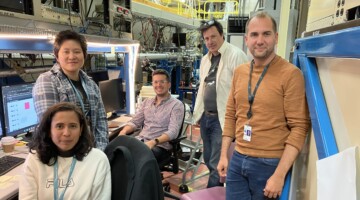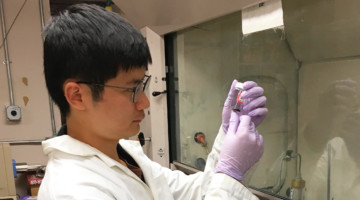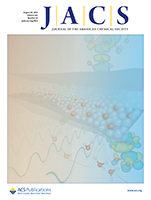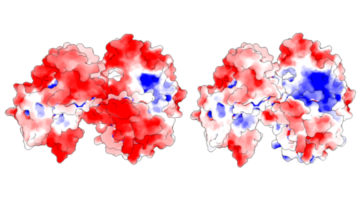Scientists at the Advanced Light Source are developing automated beam optimization systems, collaborating with other light sources to deploy common controls across facilities. Using machine learning, they demonstrated automated beamline alignment that optimizes beam size and flux at the push of a button. Read more »
Comparative Pore Structure and Dynamics for Bacterial Microcompartment Shell Protein Assemblies in Sheets or Shells
Bacterial microcompartment proteins can assemble into multiple structures, such as sheets, shells, and intermediates. While this is shown artistically in this figure, we study the differences in the pore dynamics within bacterial microcompartment assemblies to assess potential changes in permeability. Read more »
Multimodal Study of Ion-Conducting Membranes
Using multiple x-ray characterization tools, researchers showed how chemical and structural changes improve the performance of a novel ion-conducting polymer (ionomer) membrane from 3M Company. The work provides insight into factors impacting the proton conductivity of ionomers used for fuel cells and the production of hydrogen fuel. Read more »![]()
![]()
ALS Confirms Mechanism for Improved Fuel Cell Catalysis
Aided by x-ray absorption spectroscopy at the ALS, researchers from Toyota and the University of Akron have uncovered a new catalysis mechanism to improve oxidation-reduction reactions in certain fuel cells by 40%. This enhancement, based on tin oxide, will support efforts to increase fuel efficiency in electric vehicles. Read more »![]()
Chemical and Morphological Origins of Improved Ion Conductivity in Perfluoro Ionene Chain Extended Ionomers
Resonant x-ray scattering and x-ray absorption spectroscopy with elemental sensitivity unravel structural features tied to water–ion domains and discern sulfur-containing groups in sulfonated ionomers, which help delineate chemical factors controlling their phase-separated morphology and governing ion transport. Read more »
Sulfur-linked cyanobiphenyl-based liquid crystal dimers and the twist-bend nematic phase
The synthesis and characterization of cyanobiphenyl-based liquid crystal dimers containing sulfur links between the spacer and mesogenic units are described. Resonant x-ray scattering studies of the twist-bend nematic phase at both the carbon and sulfur absorption edges were performed to determine the critical behaviour of the helical pitch at the transition to the nematic phase. Read more »
How Light-Harvesting Bacteria Toggle Off and On
Researchers clarified the atomic-level mechanism that enables bacteria to switch light harvesting off and on in response to potentially damaging overexposure to light. The results could have long-range implications for artificial photosynthesis and optogenetics—the use of light to selectively activate biological processes. Read more »![]()
![]()
Catalyst Improves Cycling Life of Magnesium/Sulfur Batteries
Magnesium/sulfur batteries hold promise as a safer, energy-dense advancement, but previous iterations have suffered from extremely limited recharging capabilities. Studies at the ALS provided electrochemical insights into battery polarization and revealed how a titanium catalyst activates magnesium/sulfur compounds to improve battery performance. Read more »
Clarifying the Working Principle of a High-Capacity Battery Electrode
Operando x-ray absorption spectroscopy experiments revealed the electrochemical reaction mechanism of molybdenum disulfide (MoS2) electrodes in lithium-ion battery cells. The work unambiguously clarifies that the MoS2 conversion reaction is not reversible and that the Li2S formed is converted to sulfur in the first charge process. Read more »
X-Ray Footprinting Solves Mystery of Metal-Breathing Protein
Scientists have discovered the details of an unconventional coupling between a bacterial protein and a mineral that allows the bacterium to breathe when oxygen is not available. The research could lead to innovations in linking proteins to other materials for bioelectronic devices such as sensors that can diagnose disease or detect contaminants. Read more »









